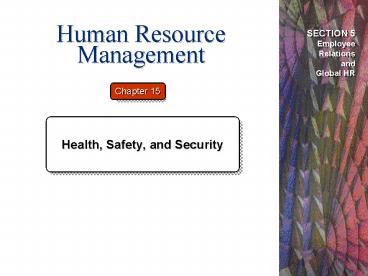Human Resource Management - PowerPoint PPT Presentation
1 / 25
Title:
Human Resource Management
Description:
Define health, safety, and security and explain their importance in organizations. ... Source: Based on data from Liberty Mutual Group, in 'Insurer Ranks Leading ... – PowerPoint PPT presentation
Number of Views:47
Avg rating:3.0/5.0
Title: Human Resource Management
1
Human ResourceManagement
SECTION 5EmployeeRelationsandGlobal HR
Chapter 15
- Health, Safety, and Security
2
Learning Objectives
- After you have read this chapter, you should be
able to - Define health, safety, and security and explain
their importance in organizations. - Discuss several legal requirements affective
health and safety. - Identify the basic provisions of the Occupational
Safety and Health Act of 1970. - Describe the Occupational Safety and Health
Administration (OSHA) inspection and
record-keeping requirements.
3
Learning Objectives (contd)
- Discuss the activities that comprise effective
safety management. - Discuss three different workplace health issues
and how employers are responding to them. - Explain the three levels of health promotion in
organizations. - Discuss workplace violence as a security issue
and describe some components of an effective
security program.
4
Health, Safety, and Security
- Health
- A general state of physical, mental, and
emotional well-being. - Safety
- A condition in which the physical well-being of
people is protected. - Security
- The protection of employees and organizational
facilities.
5
Typical Division of ResponsibilitiesHealth,
Safety, and Security
Figure 151
6
Legal Requirements for Safety and Health
- Workers Compensation
- A legally-mandated insurance fund that provides
compensation to employees for work-related
injuries. - Family Medical Leave Act (FMLA)
- Allows eligible employees to take up to 12 weeks
of leave for their serious health conditions. - Americans with Disabilities Act (ADA)
- Employers attempting to return injured employees
to light duty work may undercut the essential
functions of the job.
7
Workers Compensation Injuries
Source Based on data from Liberty Mutual Group,
in Insurer Ranks Leading Workers Comp
Injuries, National Underwriter, March 19, 2001,
7.
Figure 152
8
Selected Child Labor Hazardous Occupations
Figure 153
9
Occupational Safety and Health Act
- Occupational Safety and Health Act of 1970
- Passed to assure safe and healthful working
conditions. - Occupational Safety and Health Administration
(OSHA) administers provisions of the Act. - OSHA Enforcement Standards regulate equipment and
working environments - The general duty of employers to provide safe
and healthy working conditions. - Notification and posters are required of
employers to inform employees of OSHAs safety
and health standards.
10
Private Industry Injury Rate
Figure 154
Source Bureau of Labor Statistics, U.S.
Department of Labor, 2001.
11
OSHA Provisions and Standards
Hazard Communication
Material Data Safety Sheets (MSDS)Lock out/tag
out regulations
Blood-borne Pathogens
Protection for workers exposed to blood and other
substances from AIDS
Personal Protective Equipment (PPE)
Hazard analysis, training, and provision of PPE
to employees
Cumulative Stress Disorders (CTDs)
Protection from muscle and skeletal injuries from
repetitive tasks
Work Assignments
Protection for reproductive health and refusal to
perform unsafe work
12
Guide to Recordability of Cases Under the
Occupational Safety and Health Act
Source U.S. Department of Labor Statistics, What
Every Employer Needs to Know About OSHA Record
Keeping (Washington, DC U.S. Government Printing
Office).
Figure 155
13
OSHA Inspections
- On-the-Spot Inspections
- Compliance officers
- Marshall v. Barlows, Inc.
- Dealing with an Inspection
- Citations and Violations
- Imminent danger
- Serious
- Other than serious
- De minimis
- Willful and repeated
14
Most Frequently Cited OSHA Violations(General
Industry, Non-Construction)
Source U.S. Department of Labor, Occupational
Safety and Health Administration, 2001. Available
at www.osha.gov.
Figure 156
15
Workplace Injuries by Employment Size
Source Bureau of Labor Statistics, U.S.
Department of Labor, 2001.
Figure 157
16
Approaches to Effective Safety Management
Figure 158
17
Other Safety Issues
Safety Policiesand Discipline
SafetyCommittees
Employee and WorkplaceSafety
EmployeeMotivationand Incentives
Safety Trainingand Communications
18
Phases of Accident Investigation
Figure 159
19
Health
WorkplaceHealth Issues
20
Common Signs of Substance Abuse
Figure 1510
21
Health Promotion Levels
Source Developed by Kay F. Ryan (Nebraska
Methodist College) and Robert L. Mathis
(University of Nebraska at Omaha). May not be
reproduced without permission.
Figure 1511
22
Security
- Top Eight Security Concerns at Work
- Workplace violence
- Internet/intranet security
- Business interruption/disaster recovery
- Fraud/white collar crime
- Employee selection/screening concerns
- General employee theft
- Unethical business conduct
- Computer hardware/software theft
23
Profile of a Potentially Violent Employee
Figure 1512
24
Workplace Violence
DomesticCauses
Management Responses
WorkplaceViolenceIssues
Training in Detection and Prevention
25
Security Management
WorkplaceSecurity































